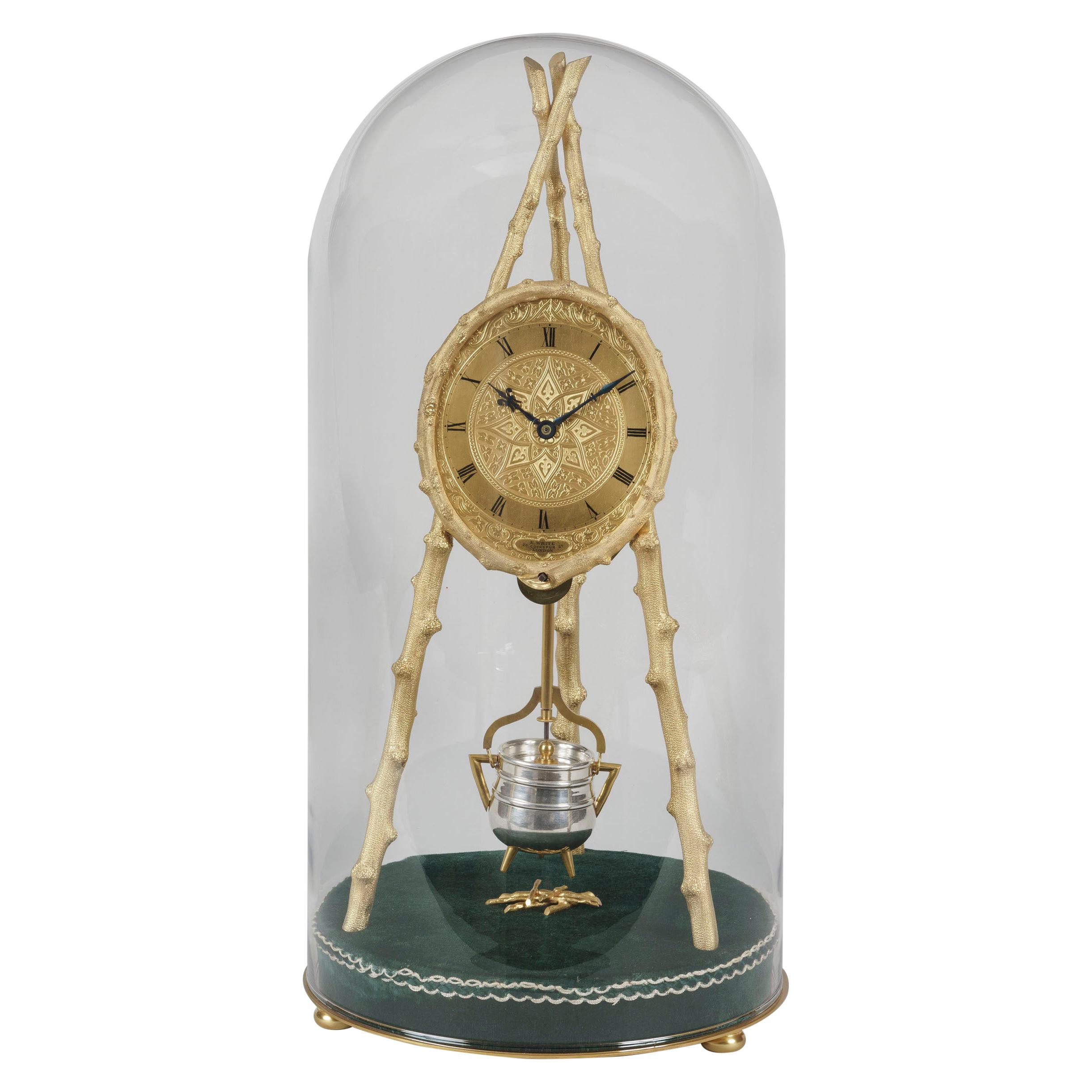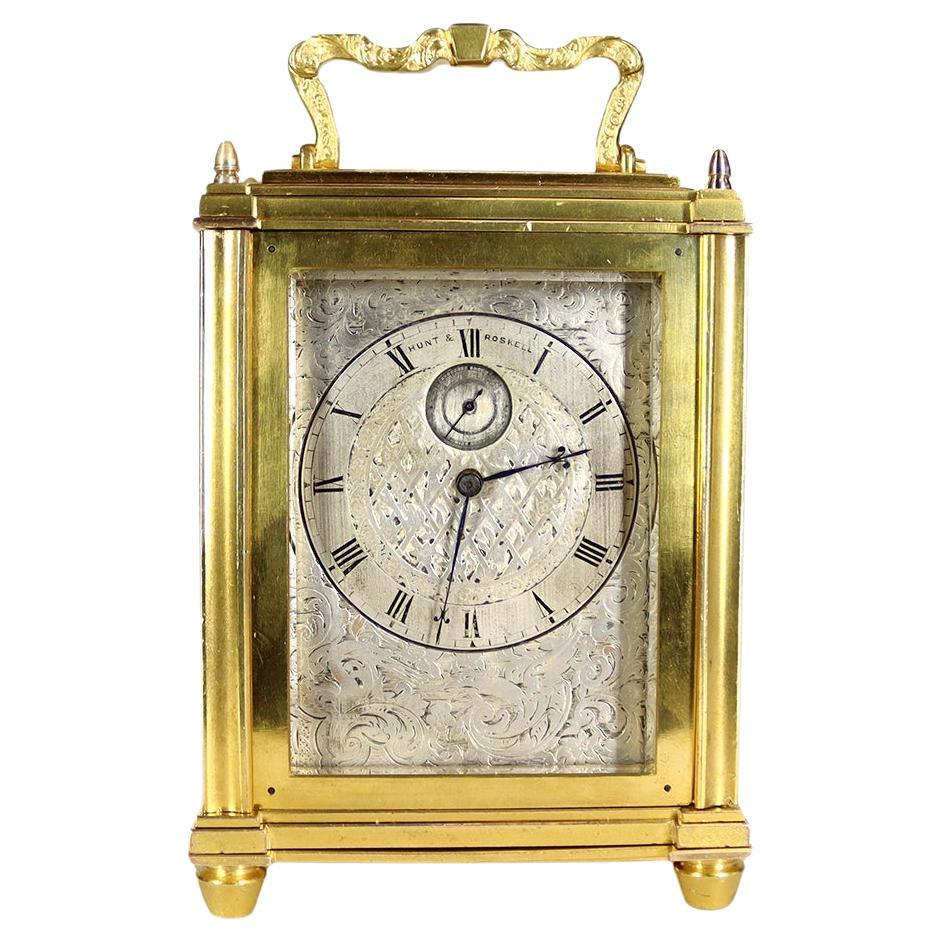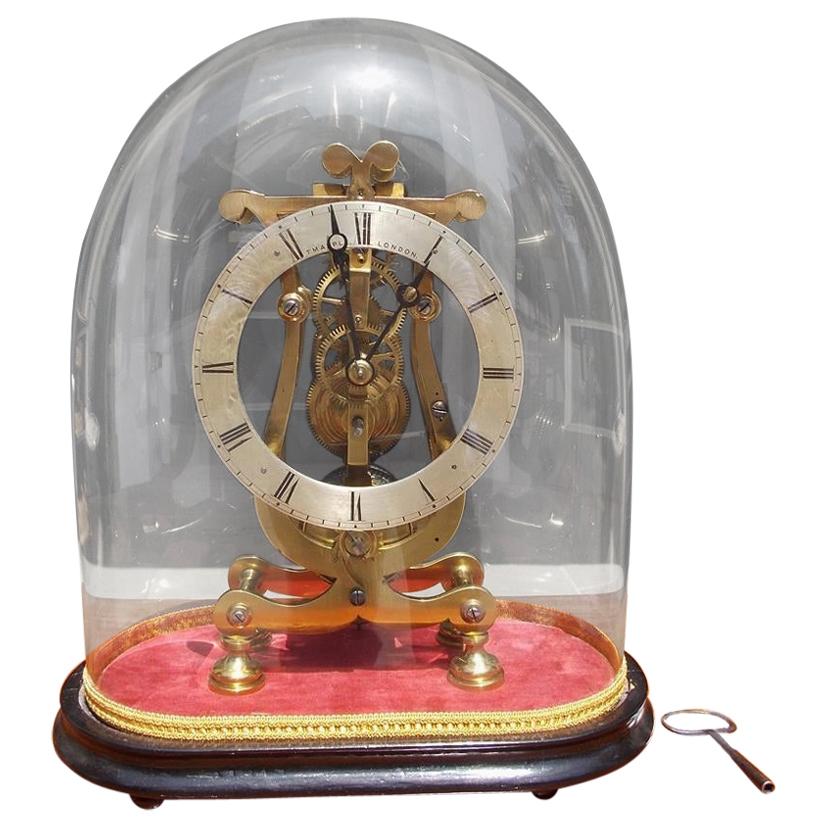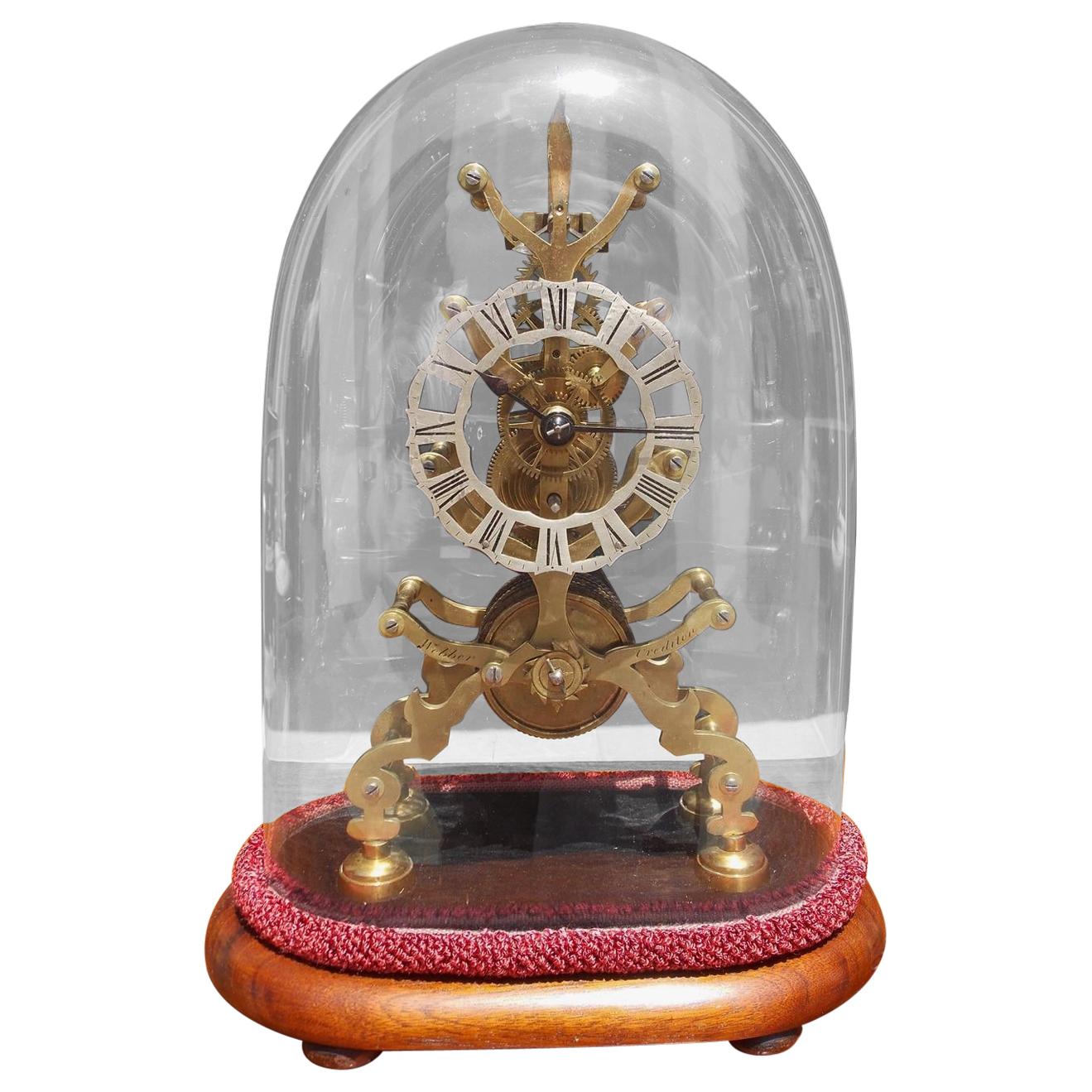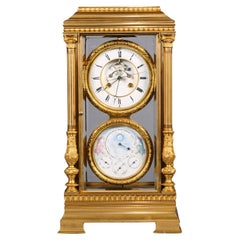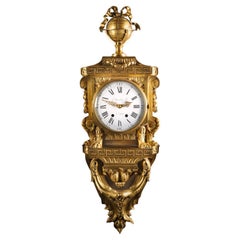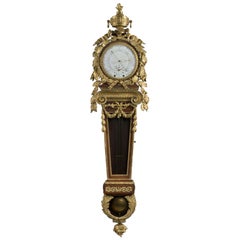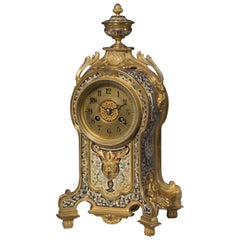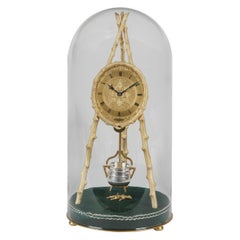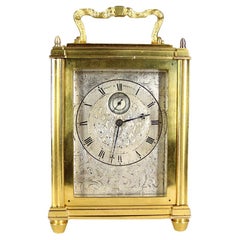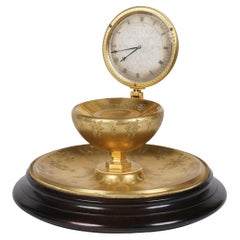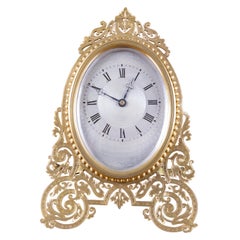Items Similar to English Tripod Table Regulator Clock by Thomas Cole, Retailed by Hunt & Roskell
Want more images or videos?
Request additional images or videos from the seller
1 of 10
English Tripod Table Regulator Clock by Thomas Cole, Retailed by Hunt & Roskell
$64,090.82
£48,000
€55,543.60
CA$90,306.78
A$99,436.45
CHF 51,562.15
MX$1,177,601
NOK 654,548.48
SEK 611,749.73
DKK 414,844.92
About the Item
A Fine English Tripod Table Regulator Clock by Thomas Cole, With Integral Thermometer and Barometer, Retailed by Hunt & Roskell, London
Signed to the dial for the retailer ‘Hunt & Roskell, London.’
No. 1318 /38
The circular six-inch silvered dial with cast bezel, signed ‘Hunt & Roskell, London’, above Roman chapters and blued steel spade hands, set with a large subsidiary seconds dial below XII, the centre finely engraved with scrolling strapwork decoration. The steel winding square protruding through an engraved and shaped plate immediately below 6 o'clock with handset achieved by adjustment to the rear. The movement with tapered plates joined by cylindrical screwed pillars, a two-part backplate, a going barrel, and deadbeat escapement. The pendulum suspended from the apex of the tripod from a G-bracket, with plumb line above, fine regulation achieved by a sliding cylindrical weight on the rod, terminating in a heavy silvered spherical bob secured via Cole's pendulum-locking system.
The case formed of three cylindrical rods set on a gilt and stepped circular base engraved with scrolling foliage, the recessed centre with a semi-circular glazed barometer with silvered register scale, blued steel hand and manually adjustable gilt recording hand. The tilted thermometer within an engraved and gilded surround. Below the tip of the pendulum is a beat scale resting on a bimetallic bar providing thermal compensation, the base resting on three adjustable gilt-metal levelling nuts.
Retaining its original glass dome and brass winding key.
England, Circa 1855.
This fine and rare timepiece by Thomas Cole is a masterpiece of design.
Described by Hawkins in 'Thomas Cole & Victorian Clockmaking' as “the first English table regulator for a gentleman’s library table,” Cole’s strut clock underwent over eight iterations before achieving a design that combined precision with extraordinary elegance.
The use of a tripod to determine the optimal pendulum suspension point is just one of several ingenious mechanisms Cole employed. Three adjustable nuts serving as feet allow for effective levelling of the clock, while a plumb line and bob ensure precise vertical alignment. Relocating the winding square directly beneath the dial eliminates the risk of scratching the surface or damaging the hands, while the inclusion of a thermometer, angled at 45 degrees, effectively conceals the beat scale and pendulum locking mechanism.
Ingeniously designed, the locking mechanism positioned just below the pendulum’s tip includes a beat scale resting on a brass bar that can be raised to secure the pendulum in place. This mechanism also provides thermal compensation through a bi-metallic strip, which automatically raises or lowers the bob in response to temperature fluctuations.
Both inventive and aesthetically striking, this rare clock exemplifies the highly ornamental Victorian timepieces created by Thomas Cole for prestigious London retailers such as Hunt & Roskell, C.F. Hancock, and R. & S. Garrard in the mid-nineteenth century.
- Creator:Thomas Cole (Clockmaker) (Clockmaker)
- Dimensions:Height: 20.87 in (53 cm)Diameter: 9.45 in (24 cm)
- Style:Victorian (Of the Period)
- Materials and Techniques:
- Place of Origin:
- Period:
- Date of Manufacture:Circa 1855
- Condition:Wear consistent with age and use. The movement of the clock is clean and currently running well.
- Seller Location:Brighton, GB
- Reference Number:Seller: B782201stDibs: LU1028044241002
About the Seller
5.0
Recognized Seller
These prestigious sellers are industry leaders and represent the highest echelon for item quality and design.
Established in 1964
1stDibs seller since 2014
59 sales on 1stDibs
Typical response time: 1 hour
Associations
The British Antique Dealers' AssociationLAPADA - The Association of Arts & Antiques Dealers
- ShippingRetrieving quote...Shipping from: Brighton, United Kingdom
- Return Policy
More From This Seller
View AllA Large Gilt-Bronze Four-Glass Mantel Regulator Calendar Clock
Located in Brighton, West Sussex
A Large Gilt-Bronze Four-Glass Mantel Regulator Calendar Clock.
The architectural case composed of two columns supporting a stepped top. The front and back with bevel glazed doors. The enamel clock...
Category
Antique 19th Century French Victorian Mantel Clocks
Materials
Enamel, Ormolu
A Louis XVI Style Gilt-Bronze Cartel Clock, by Beurdeley
By Alfred Emmanuel Louis Beurdeley
Located in Brighton, West Sussex
A Fine Louis XVI Style Gilt-Bronze Cartel Clock, by Beurdeley.
Signed 'A Beurdeley Fils à Paris'.
Surmounted by a ribbon tied globe the gilt-bronze case of this fine cartel clock...
Category
Antique 19th Century French Louis XVI Wall Clocks
Materials
Bronze
Louis XVI Style Mahogany Cartel Clock and Barometer, After Carlin, circa 1870
By Martin Carlin
Located in Brighton, West Sussex
A fine Louis XVI style gilt-bronze mounted mahogany cartel clock and barometer, after the model by Martin Carlin.
French, circa 1870.
The dial sig...
Category
Antique Late 19th Century French Louis XVI Wall Clocks
Materials
Bronze
Fine Gilt-Bronze and Champlevé Enamel Clock, circa 1880
Located in Brighton, West Sussex
A fine gilt bronze and champlevé enamel clock.
French, circa 1880.
The movement with impressed stamp to the backplate 'Vincenti et Cie 'Médaille D'Argent 1855', 'PARIS'.
Thi...
Category
Antique Late 19th Century French Mantel Clocks
Materials
Bronze, Enamel
Empire Clock in the Form of a Classical Urn, by Maison Lepautre, circa 1825
By Pierre-Basile Lepaute
Located in Brighton, West Sussex
A gilt bronze Empire clock in the form of a classical urn, by Maison Lepautre.
French, circa 1825.
The dial signed 'Lepaute a Paris'.
The clock has an ornate cast bezel with a 3-inch porcelain dial with Roman numerals and Breguet style hands. The twin train eight-day movement with outside count wheel striking on a bell and silk thread suspension.
This elegant Empire style clock has a gilt bronze case in the form of a classical urn with swan neck handles and a winged cherub to the neck. The circular pedestal base is raised on a footed stepped square plinth.
The Lepaute family were the premier French clockmakers of their day. Their significance lies in their contribution to the clock making industry which had hitherto come under the trade of locksmiths. The family held the brevet Horlogers du Roi.
Jean-André Lepaute (1720–1789) arrived in Paris at an early age and in 1740 founded the family business. A skilled artist and mechanic, he quickly gained an excellent reputation. He was received as maître by the clockmakers guild in 1759, was granted royal lodgings from the king in The Luxembourg Palace, and was entrusted with the construction of the majority of the great public clocks of Paris. He executed, amongst others, those in The Luxembourg Palace, the Jardin des Plantes, the Château de Bellevue and the Château des Ternes. His clock at Paris’s École Militaire still works today. Three editions of his Traité d’Horlogerie were published in Paris in 1755, 1760 and 1767. A small volume, Description de Plusieurs Ouvrages d’Horlogerie appeared in 1764. Jean-André’s wife, Nicole-Reine Etable de la Brière (1723-1788), was a highly esteemed mathematician and astronomer. Her passion for science lent itself to Lepaute’s work and she played an active role in the scientific and mathematical aspects of the clock making.
Jean-André’s younger brother Jean-Baptiste Lepaute (1727-1802) joined him in Paris in 1747 and immediately started working for the family business. He was received as maître in 1776 and was known for the clocks he constructed for the Paris Hôtel de Ville (1780), destroyed in a fire of 1871, and for the Hôtel des Invalides (1784). Jean-Baptiste took over the workshop when Jean-André retired in 1775.
After Jean-Baptiste’s death in 1802, the firm was taken over by his nephew Pierre-Basil Lepaute (1750-1843) where he was duly joined by his own nephew Jean-Joseph (1768-1846) and son Pierre-Michel (1785-1849). By 1816, Pierre-Michel Lepaute was in charge of the business. His masterpieces include the astronomical clock in Paris’s Bureau...
Category
Antique Early 19th Century French Empire Mantel Clocks
Materials
Bronze
Napoléon III Gilt-Bronze Double-Faced Clock. French, c 1870
By Julien Le Roy
Located in Brighton, West Sussex
A rare Napoléon III gilt bronze double-faced clock.
The white enameled dial signed 'Julien Le Roy A PARIS'.
This rare Rococo style figural clock h...
Category
Antique Late 19th Century French Napoleon III Table Clocks and Desk Clocks
Materials
Bronze
You May Also Like
Early Tripod Table Clock by Thomas Cole with Glass Dome
Located in London, GB
An extraordinary rustic tripod table clock
by Thomas Cole
Retailed by E. White of London
The circular green velvet-clad base supporting three equidistantly spaced brass imitation logs, from which the clock and its mechanism are suspended; housed within a brass bezel conformingly styled as naturalistic logs, the circular etched and engraved gilt dial with elegant blued steel hands, marked at 6 o'clock "E. White, 20 Cockspur St, London", having the hours marked in Roman numerals; the tapered two-tier movement has a six wheel train with five-spoke crossings between spotted plates, the upper section fixed by blued steel screws to the backplate, enclosing a Brocot-style deadbeat escapement incorporating rubies and train to the centre wheel, the pendulum of most unusual design styled as a lidded cauldron over a simulated fire. Complete with a glass dome and key. The front plate numbered “1637.”
London made, circa 1861
Thomas Cole, (1800-1864)
Son of Thomas Cole Snr, a Somerset clockmaker, his history and works are fully recorded in 'Thomas Cole & Victorian Clockmaking' by John B. Hawkins, published 1975, in Sydney. Known as a specialist in making decorative timepieces of the highest quality, Cole exhibited at the Great Exhibition at the Crystal Palace in 1851; he warranted an 'honourable mention' in the Paris Exhibition of 1855 and the London 1862 Exposition International, where he was awarded a medal for 'excellence of taste and design'.
Hawkins discuss Thomas Cole's tripod clocks...
Category
Antique 19th Century English Table Clocks and Desk Clocks
Materials
Brass, Ormolu, Bronze
Single Fusee Carriage Timepiece By Thomas Cole and James Cole, Retailed By Hunt
By Thomas Cole (Clockmaker)
Located in Amersham, GB
A miniature carriage clock timepiece by Thomas Cole and his brother James Fergusson Cole. The eight day single fusee movement with english lever escapement.
The case is decorated with the ‘Rose and Trellis’ pattern as seen on another of Coles clocks retailed by Edward Dent with the same handle and case construction ( JB Hawkins, “The Hawkins Pictorial Survey of Cole Clocks...
Category
Antique 1840s English William IV Carriage Clocks and Travel Clocks
Materials
Brass, Steel, Ormolu
Rare 19th Century Brass Engraved 'Inkwell' Table Clock attributed to Thomas Cole
By Thomas Cole (Clockmaker)
Located in London, GB
An Unusual 'Inkwell' Table Clock
Attributed to Thomas Cole
Constructed from gilt brass, the novelty timepiece rising from a turned ebonised base inset with a concave brass tray e...
Category
Antique 19th Century English Table Clocks and Desk Clocks
Materials
Brass, Bronze
Early Victorian Gilded Strut Clock in the Style of Thomas Cole
Located in Norwich, GB
Early Victorian Strut clock in the style of Thomas Cole.
Gilded frame with engraved scroll work, oval beaded bezel surrounding a beautiful e...
Category
Antique 1840s French Victorian Mantel Clocks
Materials
Brass
English Brass & Polished Steel Skeleton Clock Under Glass Dome T. Mapple C 1850
By T. Mapple
Located in Charleston, SC
English brass skeleton clock under original glass dome with a polished steel roman numeral dial, fusee chain movement, and affixed to an oval carved wood felt base with four bun feet...
Category
Antique 1850s English Victorian Mantel Clocks
Materials
Brass, Steel
English Brass and Polished Steel Skeleton Clock Under Glass Dome Webber, C. 1870
By Webber
Located in Charleston, SC
English brass skeleton clock under original glass dome with a polished steel roman numeral dial, fuse chain movement, and affixed to an oval carved wood felt base with four bun feet....
Category
Antique 1870s English Victorian Mantel Clocks
Materials
Brass, Steel
More Ways To Browse
Antique Tripod Tables
Used Thomas Table
Antique Thermometer
Tripod Bronze
Antique Regulator
Tripod Table Glass
Antique Garrard
Thermometer Barometer
Antique Brass Tripod
Antique Barometer Thermometer
Victorian Tripod Table
Regulator Clock
Tripod Bronze Table
Cole Steel
Antique Regulator Clocks
Gold Tripod Table
Antique Hunt Table
Hunt And Roskell
